|
 Russula pilocystidiata Russula pilocystidiata
BiostatusPresent in region - Indigenous. Endemic
Images (click to enlarge)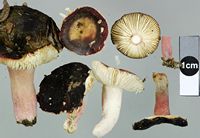
Owner: J.A. Cooper | 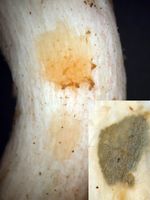
Caption: Upper:FESO4. lower: Guaiac. Inset lower right: guaiac on cut stem after 20 minutes.
Owner: J.A. Cooper | 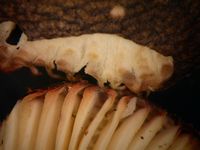
Caption: subcutis and gill edge at cap perimiter.
Owner: J.A. Cooper | 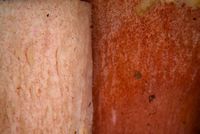
Caption: stem apex between immatire/mature.
Owner: J.A. Cooper | 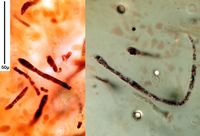
Caption: DCY in SV
Owner: J.A. Cooper | 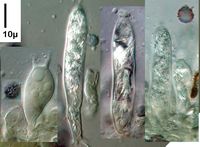
Caption: pleurocystidia
Owner: J.A. Cooper | 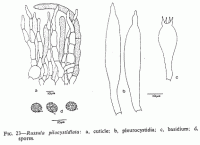 | 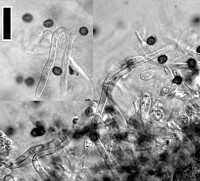
Caption: scale =20um. Spores and pileocystidia.
Owner: J.A. Cooper | 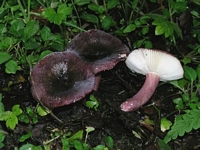
Owner: J.A. Cooper | 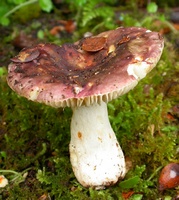
Owner: P. Leonard | 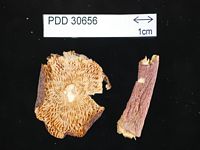
Caption: Dried type specimen
Owner: Herb PDD |
Article: McNabb, R.F.R. (1973). Russulaceae of New Zealand. 2. Russula Pers. ex S.F. Gray. New Zealand Journal of Botany 11(4): 673-730 (http://www.rsnz.org/publish/abstracts.php).
Description: pileus: 2-5 cm diam., convex when young, centrally
depressed at maturity, slightly viscid under wet conditions, otherwise dry,
innately subpruinose under lens, velar remnants absent, greyish magenta, greyish
violet, or deep vinaceous-purple, often with olive green or yellowish green
areas; margins entire, non-pectinate. Cuticle composed of erect, hyphae and
pilocystidia, often disorganised and partially gelatinised with age; hyphae
thin-walled, smooth, septate, 1.5-6 µm diam., terminal cells unspecialised,
tapering apically, originating from inflated, short-celled hyphae or sphaerocysts,
pilocystidia cylindrical to subclavate, often septate, thin-walled, apices bluntly
acuminate or mucronate, contents refractive in KOH, occasionally projecting
to 60 µm beyond general level of cuticle, 40-150 X 5-10 µm. lamellae: adnate, crowded, thin, simple or occasionally
forked near stipe, to 6 mm deep, white to pallid creamy white, not discoloured
at maturity, lamellulae rare or absent. stipe: 1.5-4
cm long, ± equal or expanded basally, 0.6-1.3 cm diam., dry, solid or slightly
chambered, finely furfuraceous under lens, pallid greyish red, rose, or pallid
greyish magenta with rose tints, often with white flesh showing through; flesh
white, unchanging on exposure to air. Cuticle composed of interwoven, repent,
thin-walled, septate hyphae 2.5-4 µm diam., terminal cells projecting and aggregated
into clumps; caulocystidia numerous, similar to pilocystidia. spores: spore print pallid creamy
white; spores broadly elliptical to ovate, obliquely apiculate, apiculus to
1.5-(2) µm long, 9-10.5 X 7.5-9 µm, ornamentation moderately dense, of amyloid
or partially inamyloid, truncated spines to 1 µm high, in small confluent groups,
joined basally by fine to moderately coarse amyloid ridges and forming nodulated
bands or an incomplete reticulum, or occasionally isolated; plage conspicuous.
hymenium: basidia hyaline, clavate, 36-45 X 10.5-13
µm, 4-spored, sterigmata to 8 µm long; pleurocystidia scattered, numerous, broadly
fusiform, hyaline, thin-walled, contents refractive in KOH, projecting to 35
µm beyond basidia, apices acuminate, strangulate, or capitulate, 60-100 X 7.5-13.5
µm; cheilocystidia rare to numerous, similar to pleurocystidia but shorter.
hymenophoral trama:
heteromerous, intermixed. context
of pileus: white, unchanging; structure heteromerous,
clamp connections absent. taste: lamellae and context mild. chemical characters: formalin on context—n.r.; phenol on context—slowly
deep vinaceous; FeSO4 on context—rapidly salmon pink—guaiacol on stipe base—n.r.;
KOH on pileus—magenta colour disappears leaving area orange-red: on context
—n.r.; NH4OH on pileus and context—n.r.
Habitat: Solitary or in pairs under Nothofagus.
Notes: Russula pilocystidiata belongs in section Rigidae, but it is difficult
to assign it to a subsection in Singer's (1962) classification.
This species is characterised by the conspicuous
pilocystidia, which often project well beyond the general level of the cuticle.
|